
Tapestry (1948)
Tapestry is a global fashion house of brands that combines the glamour of Coach, Kate Spade New York and Stuart Weitzman.
About the company
The company pushes itself in its work, brings out the unexpected in what they create, and expands the boundaries of possibility by fusing various people and ideas. Dreamers who were passionately driven to transform ideas into icons were the ones who created the company’s brands. They have expanded by meeting people worldwide who share their commitment to the dream. Every tool, procedure, and individual involved in their work is held to the highest standards, and they intentionally embrace difference because different viewpoints are what spark creativity.
They discover greatness where beauty and function, tradition and innovation, accessibility and aspiration converge, and this is how they use magic and reason to transcend their culture and craft. The company make the fashion industry more sustainable, empower their communities, and create an equitable, diverse, and inclusive home by bringing together their collective strengths.

Its history
Three well-known brands are owned by Tapestry, Inc., an American multinational luxury fashion holding company with headquarters in New York City. Founded as a family-run business in 1948, by the entrepreneur named Donald J. Fisher. The company was first known as The Gap, Inc. and it was originally based in San Francisco. During the 1970s and 1980s, the company expanded into alternative markets such as Banana Republic, Old Navy, GAP and Athleta. In 1985, Fishers’s business became one of the largest retailers in the world.
The firm declared in 2017 that it intended to split off its luxury fashion brand division into a different publicly traded business.
Later on, it developed into a corporation with more than 17,000 workers and increased the scope of its offerings by purchasing brands like Stuart Weitzman, in 2018, and Kate Spade a year before. On October 31, 2019, the company rebranded itself as Tapestry to more accurately reflect its expanded product line that included items other than handbags bearing the Coach brand.
Tapestry declared in August 2023 that it would pay $8.5 billion to acquire Capri Holdings, that owns Jimmy Choo, Michael Kors, and Versace.
Who owns Tapestry
Since Tapestry, Inc. is a publicly traded business, its shareholders own a portion of the company. Institutional investors, such as Vanguard Group Inc., BlackRock Inc., and State Street Global Advisors Inc., accounted for the majority of the company’s shareholders as of 2021. These institutional investors have significant input in the company’s decisions and hold substantial stakes in it.
- Tapestry’s largest shareholder is Vanguard Group Inc. Of the outstanding shares of the company, the investment management company possesses approximately 15.28%.
- Holding roughly 10.99% of Tapestry’s outstanding shares, BlackRock Inc. is the company’s second-largest shareholder.
- State Street Global Advisors Inc., with approximately 5.45% of the outstanding shares of the company, is the third largest shareholder.
In addition, The Vanguard Group (Australia), T. Rowe Price Associates Inc., Capital World Investors, and other institutional investors are among the individual investors who hold a sizable portion of Tapestry’s shares. Retail investors also purchase and sell the company’s shares on stock exchanges such as the New York Stock Exchange (NYSE).
Their values

“Taken together, our values define who we’ve always been and guide what we’ll become.”
Committed to the Dream
Despite being a worldwide corporation, they have a strong desire for longevity in New York. Designed by visionaries who saw unmet needs and made risky decisions, they still channel that same passion today. They will not accept anything less since they are aware of the sheer courage and intelligence required to realize the dream. They are a community that never gives up, always thinks ahead, and acts on their curiosity; Tapestry allows them the space to do all of that. They get back up after being knocked down. As Well as they have earned, not inherited, their successes.
Preserve High Standards
Tapestry is devoted where it matters—in their people, their procedures, and their goods. They take pride in maintaining their reputation for meticulous craftsmanship and unwavering quality in all they do. They insist on the utmost integrity at every turn, from sourcing to sewing to selling. Here, the interactions that their clients have with their brands are crucial and revered. They are utterly committed to them and to one another, so they go above and beyond to complete tasks correctly because that’s when it counts most.
Accept the Differentiation via Design
The greatest assets they possess are diverse perspectives, as only in these places can one find the kind of ingenuity that turns objects into icons and draws heads. They create something completely new when they encourage everyone to speak up and combine these many voices. Rather than the other way around, they provide a platform for customers’ voices to be heard through their brands. They stand for open doors at Tapestry.”So come as you are. Let’s create something from it”.
Make History Using Logic and Magic
Science and art. Data and design. Happiness and discipline. They believe that breakthroughs and the foundation of their reputation are found in the interplay of these forces. By combining inspiration and customer insights, they can discover new opportunities for collaboration, make unanticipated connections, predict future developments and provide better customer service. Their products are not just exquisite, they are also beautifully useful, and their employees understand that strategy and aesthetics go hand in hand. Since they consider business to be an art and form to be a function.
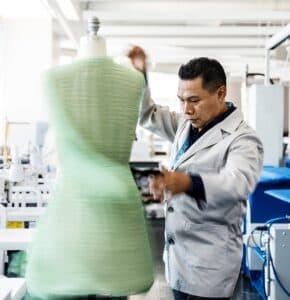
Stand Taller Together
Combining many talents increases their impact, and using expertise to one’s advantage opens up a world of possibilities. At Tapestry, they lay the groundwork that allows their brands to flourish on their own and provide the roof under which their people can exchange information and education. When they collaborate, they raise the bar for themselves and each contribute to more significant accomplishments. They are the ones who can revolutionize this sector by working together. “Together, we stand taller” .
Social responsibility
Employees at Tapestry are encouraged to look forward to contributing to the workplace and feel completely supported in their pursuit of personal and professional development. They are commited to create a work environment that is innovative, equitable, inclusive and diverse.
“Our 2025 goals strive to expand diversity in our leadership teams and reduce gaps in feelings of inclusion by gender and ethnicity. We are embracing difference by design across all levels of our company.”
Tapestry measurements according to their social responsibility:
- Increasing the proportion of NA-based racial and ethnic minority leaders will help to better represent the overall corporate population and foster diversity in the North America (NA) Tapestry and brand leadership teams.
- Lessen the disparities in their gender and ethnicity-based Employee Inclusion Index scores.
- Fill 60% of leadership positions (VP+) internally to show the commitment to career advancement, development, and mobility.
- Through establishing a global core benefit standard for parental and family care leave policies, as well as self-care, you can empower all employees to manage the balance between their personal and professional lives.
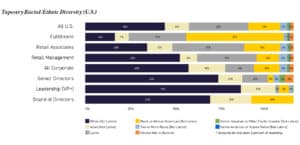
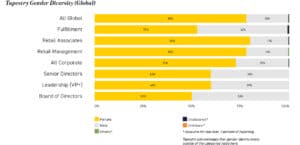
Sustainability
Planet goals for 2025 and beyond
They constitute the following objectives to decrease their environmental impact:
- By FY2030, cut the absolute Scope 1, 2, and 3 GHG emissions by 42.5% below FY2021.
- By 2025, all Tapestry stores, offices, and fulfillment centers will use only renewable energy.
- By 2025, reduce water use by 10% throughout their supply chain from a 2020 baseline and within their own operations from a 2018 baseline.
They guarantee to source their materials in an ethical and responsible manner:
- By 2025, the goal is that 90% of leather originates from tanneries rated Silver or Gold by the Leather Working Group (LWG).
- By 2030, 10% of leather will come from regenerative agriculture-practicing farms, be made with recycled materials, or be made with next-generation materials.
- By the year 2027, pre- or post-consumer recycled materials will account for 95% of the polyster.
- By 2025, pre- or post-consumer recycled sources will account for 95% of recycled polyamide, or nylon.
- By 2025, 90% of cotton will have an organic or regenerative certification.

Preserving and Restoring Biodiversity
As a company, Tapestry continues to place a high priority on preserving biodiversity in ecosystems worldwide, particularly with regard to deforestation in major leather-producing nations. The Tapestry Foundation and World Wildlife Fund (WWF) announced in April 2022 a $3 million, four-year partnership to support the creation of a leather traceability system in Brazil. This was a significant turning point in the nation’s effort to achieve zero deforestation in areas that produce leather.
Waste and Recycling
Achieving their circular goals requires lowering waste output and developing more practical and scalable product end-of-life solutions. In less than 18 months, the Coach (Re)Loved program expanded from a pilot program to a full portion of the brand’s business, serving as an example in this regard. Over 17,000 bags have been repaired by Coach (Re)Loved repair technicians to date.
Brands
Coach
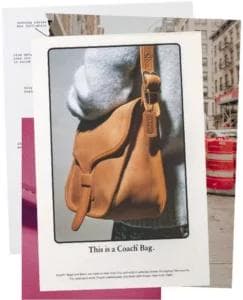
“For 80 years, Coach has inspired the dreamer in all of us. As we write our next chapter, we’re building on our heritage of craftsmanship and confident New York style to deliver a complete lifestyle brand for modern lives”.
The international fashion house Coach was established in 1941 in New York. They create beautiful, long-lasting items that allow the customers to be they are, inspired by the inclusive and brave spirit of our hometown and Creative Director Stuart Vevers’ vision.
Kate Spade
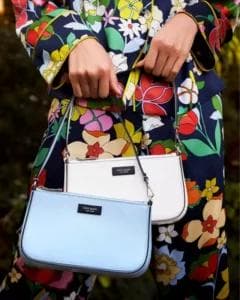
“At Kate Spade New York, we design extraordinary things for the everyday. Our lifestyle brand offers something unique and universal. We’re bold and optimistic and known for celebration. Joy causes a chain reaction, and for us, it starts with our internal community and the values that guide everything we do”.
Ever since their 1993 debut featuring six staple handbags, they have consistently represented positive, feminine style. They appreciate well-considered details. The brand think sophisticated, modern colors have great power and that polished ease feels and looks stylish. Their look is a byword for happiness. Within the Tapestry family of brands, Kate Spade New York’s distinct fashion point of view is defined by these core values.
Stuart Weitzman

“Stuart Weitzman footwear has long been synonymous with a minimalist, sophisticated sensibility, timeless style, luxurious quality, and artisanal Spanish craftsmanship. Our goal is to continue to be the ultimate shoe destination for high-fashion, high-function shoes that inspire women to shine with confidence”.
Stuart Weitzman has been influenced by strong, bold, seductive, and self-assured women since 1986.
Their dedication to fostering employee confidence in all they do is the source of their commitment to fostering customer confidence via style and comfort. From their talented artisans in Spain who are committed to quality and craftsmanship to their design team in New York City, who is focused on creating high-fashion, high-function looks that offer a thoughtful luxury experience. They value taking risks, coming up with new ideas constantly, and fostering creativity. They strive to let each person’s unique qualities show through so that as a team, they can work together more effectively and cooperatively.
Current situation
As the luxury market consolidates, Tapestry plans to pay roughly $8.5 billion to acquire Capri Holdings, the parent company of Versace, Jimmy Choo and Michael Kors. The transaction between two sizable American businesses with well-known luxury brands occurs as upscale merchants search for expansion in the face of indications that discretionary spending by American consumers is declining. Additionally, it coincides with the competition among the leading luxury players to acquire brands and expand their portfolios. Together, the two groups would bring together Versace, Jimmy Choo, Michael Kors, and brands like Coach, Kate Spade, and Stuart Weitzman, with an estimated $12 billion in revenue. Following the completion of the transaction, they will conduct business as Tapestry.
The chief executive officers of Capri and Tapestry emphasized that the merger would provide them access to additional resources and expand the market for their clothing, shoes, and handbags. While Capri’s brands will see increased exposure in Asia, the acquisition will aid in Tapestry’s expansion throughout Europe, the Middle East, and Africa.
The companies claimed that within three years, the merger would allow them to increase their direct-to-consumer business and save $200 million in operating and supply-chain expenses.
Executives highlighted that sharing resources would enable their brands to share supply chains, transportation, and digital and marketing skills—a tactic known as synergies.
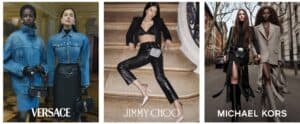
To conclude, Tapestry is a global fashion house that owns brands such as Coach, Kate Spade New York and Stuart Weitzman, which also recently acquired Capri Holdings Group.
Read more:

Aura Blockchain (2021)

